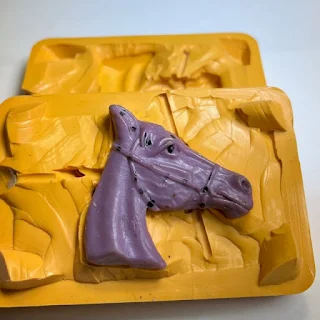In honour of our own "Taf Schaefer, on Ganoksin", who asked me one simple question. "Gerry, What is the percentage of shrinkage when you're casting metals?
Our own "Taf" mentioned to me that she does a lot glass designing with the "Steuben Glass Company". In fact, she was one of the leaders with that fantastic glass company where I once visited in Upper area of New York State, USA. You can see some of her wonderful sculpturing at "Stueben.com" and to think she is one of 'us' on Ganoksin. We are all honoured, as I am for sure, just go to their website and see many of her beautiful designs.
The next query got answered, how do you get the wax removed from the two halves of the rubber mold, without getting the wax broken or destroyed in the removal-process?
Google mentioned using a basic "Lubricant" that is in having "Talcum-Powder" as a the guide. I knew this for myself after seeing this first-hand, when I was learning my Diamond Setting, some 63 years ago. I took so much for granted then, but not understanding the real reasons. If that jeweller said 6%, I took it for granted that he/she were right. But never ever, questioned them...!!!
Today, we use a liquid to spray the rubber-mold to extract the warm wax from the rubber. When we get the wax removed WE MUST GET ALL OF THIS WAX CLEAN from any powder.
Some jewellers immerse the 'powder encased wax' into a water-based solution. Why is this so essential? This will give you a spotless clean wax, that is free of any powder, or other substance.
When the "weighing process" is initiated, this wax form MUST BE TOTALLY CLEAN of any extra powder-like materials. Not to mention, that every wax pattern MUST be clean of any 'extra' wax residue, this will give you "any not wanted wax" and will also give you any of that metal in your final weights. Your wax should be visually clean!!!
If I'm repeating myself, that is because this step is so darned important, in this "weighing process".
You can use any method, just to get any 'remaining wax' totally removed. I use any file of shape, grit and texture. I even bought some of these above shown files from my favourite "Dollar-Store" outlet.
At times, I will use my graver and hand-remove any of the remaining wax, as shown below.
If you can see a little 'extra' wax, try and remove everything. Those few 0.01 - 0.02 grams can add up to unnecessary $$ out of your pocket.
The "RATIO of 0.6%" is now being started, but how is it found & using what method?
Let's first state that we use this ratio of "WEIGHT X HEIGHT X DEPTH". This will easily give you the VOLUME. But what about the 6% and how is that arrived???
Taf Schaefer then asked me for the second question, will a "thick wax-sprue give us any problems", my own answer will be a definite "NO"! If you need any thick sprue, attach that AFTER the "6%" answer has been calculated.
Now just compare these two measurements, "with & without" that center sprue. This will be an interesting weight difference, agree?
How is that 6% calculated, this is a very detailed answer and so easy to understand!!
Original Metal form to your machine (squeezed) hot rubber created mold there will give you a 2.5 % shrinkage. A "Cold Mold" will not give you any of those shrinking problems.
BTW, this is a metal model is of a "Ballerina", she was created in England in 1934. This prized model now sits in our home as it was passed down from my "Beloved Parents" ever since.
You can see just how that there is NO SHRINKAGE HAS TAKEN PLACE. This cold mold refers to the fact there is no squeezing of any two hot plates for the top and the bottom. This method literally squeezes the two very hot plates and makes the rubber also very hot. Every few minutes, the two plates are squeezed again, each time closer together. At every squeezing action the temperatures are quickly measured...Squeezing again, another temperature check. few more squeezing's, until all of the hot-plates are finally FORCED together.
Just imagine how much force is being brought together? Now think of the shrinkage percentages, good grief. I couldn't even suggest a simple 2.5%, but that is how those numbers are being created.
It's so hot, that all of the semi-liquid rubber is forced into all of the crevices and recesses of a cluster ring with it's all kinds of detailing's. As for this "Ballerina" model, such a process is not needed, hence a Cold Mold will easily suffice. Plus there is no hot squeezing is needed or required. NICE?
This shrinkage problem that we're talking about is at a absolute zero...WOW & finally!!!
ANY wax will shrink from the Rubber mold at 1.0 %
Cleaning (filing) & Polishing (using the Tripoli & Rouge compounds) is another 1.0 % +.
This FINAL calculated number is 6.0 %
Some sources suggest an 8%, instead of the 6%, (I personally can't agree with those high numbers).
When you are wanting to remove any wax from the cement-like investment
what are the Fahrenheit & Celsius temperatures while in your "Burnout Oven"?
Pre-heat the oven for 3 hours 275 Fahrenheit (135.18 Celsius)
For 2 hours, put the oven to 300 F. (148.88 Celsius)
For 2 hours, get your oven to 500 F. (260.18 Celsius)
For 10 hours, at a scorching 800 F. (426.72 Celsius)
DO NOT EXCEED the insanely hot 850 F. (454.54 Celsius)
If you exceed the 850F. you could definitely burn or ruin your delicate Gemstones. This is especially when you are using the "Setting Stones in the Wax" process.
It's advisable not to set your stones into the "Burn-Out Oven" for the long duration with your "Stones in the Wax".





















.jpg)
No comments:
Post a Comment